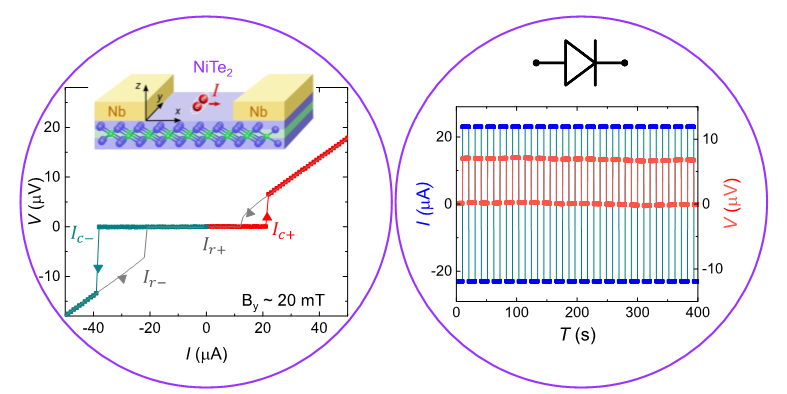Cooper pairs with finite momentum rectify supercurrent flow
In a paper published in Nature Physics, scientists at the Max Planck Institute of Microstructure Physics, Halle show that a lateral Josephson junction made from a type-II Dirac semimetal Nickel di-telluride (NiTe2) and superconducting Niobium (Nb) electrodes exhibits a large nonreciprocal critical current such that a non-dissipative supercurrent flows in the "forward" direction but a normal dissipative current flows in the "backward" direction.
Supercurrents are carried by pairs of electrons which, in conventional superconductors, have opposite spins and opposite momenta. Supercurrents are especially interesting because they dissipate zero energy unlike current in non-superconducting metals. However, when the intensity of a supercurrent exceeds a threshold value, the so-called critical supercurrent, the superconductivity properties are lost and the current dissipates energy just like a normal metal. Supercurrents can flow even through nominally non-superconducting materials when these materials are placed in close proximity to a superconducting material. An especially interesting device is a Josephson junction in which such a material is connected via two superconducting electrodes.
In a paper published yesterday (August 15, 2022) in Nature Physics scientists at the Max Planck Institute of Microstructure Physics, Halle (Saale), Germany show that a lateral Josephson junction made from a type-II Dirac semimetal Nickel di-telluride (NiTe2) and superconducting Niobium (Nb) electrodes exhibits a large nonreciprocal critical current such that a non-dissipative supercurrent flows in the "forward" direction but a normal dissipative current flows in the "backward" direction. This Josephson diode effect (JDE) is the superconducting counterpart of the familiar semiconducting diode effect. These scientists show that a small magnetic field is necessary to establish this effect and that the size of the JDE is maximized when this field is perpendicular to the supercurrent flow. Stuart Parkin comments that “this amazing Josephson diode effect has a lot of potential for superconducting cryogenic memory and logic devices that will consume very little energy. I believe that such devices are very important for the development of complete quantum computing systems”.
In a collaboration with Liang Fu and members of his group at the Massachusetts Institute of Technology, Cambridge, MA, USA, the Max Planck Institute of Microstructure Physics scientists show that a possible explanation for their observations relies on an unusual property of the electron pairs that carry the supercurrent. In a centrosymmetric superconductor these so-called Cooper pairs do not possess a measurable center-of-mass momentum. However, in the absence of time reversal and inversion symmetries the Cooper pairs can rather carry a non-zero finite momentum. Substantial and compelling experimental evidence presented in the Nature Physics paper clearly details a connection between finite momentum Cooper pairing and the Josephson diode effect.
This work is also the first to demonstrate that spin-polarized topological surface states in a Dirac semimetal (here NiTe2) can give rise to a JDE, which opens up a realm of possibilities since there are enormous numbers of materials with topological electronic structures, so it is anticipated that many of these will exhibit a JDE. “I find it really interesting that we have been able to unravel the origin of this remarkable effect and that we have done this using a topological metal, a class of materials that has always fascinated me”, comments Banabir Pal.

This work was published on August 15, 2022 in Nature Physics (Pal, B. et al. “Josephson diode effect from Cooper pair momentum in a topological semimetal”. Nat. Phys. (2022)). The scientists at the Max Planck Institute of Microstructure Physics include Banabir Pal, Anirban Chakraborty, Pranava K. Sivakumar, Ajesh K. Gopi, Avanindra K. Pandeya, Jonas A. Krieger, Mihir Date, Niels B. M. Schröter & Stuart S. P. Parkin and, at MIT, Margarita Davydova, Yang Zhang, Noah Yuan, & Liang Fu. Sailong Ju from the Paul Scherrer Institute, Switzerland, contributed to the ARPES experiments












